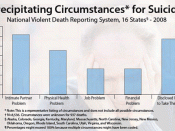The United States is plagued by a countless number of social dilemmas. Although
not in constant public scrutiny, suicide is a serious problem which has seemed to
have lost importance. When suicide is coupled with arrest and incarceration it
becomes an increasingly complex situation. In fact, research indicates that the jail
suicide rate ranges from 2.5 to 13 times greater than the rate of the general
population (Winkler 1992). Motivation, prediction, and prevention of suicidal
behavior are grossly unclear, which only adds to the already existing complexity.
Many factors involved with arrest and incarceration only serve as a catalyst of
suicidal tendencies. Suicide is the primary cause of death in this country's jails.
In 1986 there were 401 successful [jail] suicides (Winkler 19992).
There are many general assumptions made in regard to suicide. Most believe
suicide to be caused by mental illness such as major depression or bipolar disorder.
Another belief is that the emotional escalation leading to action takes place over a
long period of time.
Such is not the case in jail suicides. Much of the research
shows that ü of all [jail] suicides occur within the first twenty four hours of
incarceration, and an overwhelming number of these take place in the first three
hours of isolation which is referred to as the "crisis period" (Hess 1987). The
crisis period is reflective of arrest and incarceration as producing extreme
confusion, fear, and anxiety. The crisis period is also the result of isolation.
Isolation causes an individual to lose all social support systems. Placing an
individual in isolation may be a form of protection, but this gives the individual an
opportunity to concentrate on feelings of hopelessness (Winkler 1992). Hopelessness
can be defined as the presence of despair and negative feelings about the future
(Shneidman 1987).Isolation can...



Suicide in Jails
I think that there are a lot of suicides in the jail because if there is a person stuck in jail for life without parole, it is something that they don't want to deal with and since the death penalty has been banned in so many places, they find the easiest and painless way out would be to commit suicide. Also, I don't think there is adequate security in any of the prisons walking around to make sure that there is no trouble going on around the cells.
2 out of 2 people found this comment useful.